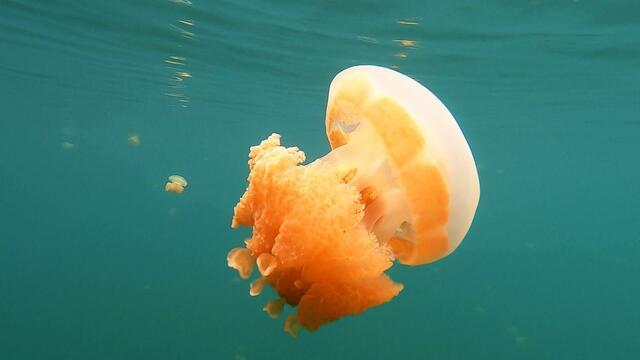▶ Watch Video: Marine scientists still baffled by lake filled with millions of jellyfish
An extraordinary place called Jellyfish Lake draws visitors every year from around the world who are looking to swim with jellyfish. Surrounded by mangrove trees, millions of the world’s rarest jellyfish can be found in the lake, which is located in the western Pacific island nation of Palau.
While some jellyfish, like the box jellyfish, can kill a person within minutes, the inhabitants of Jellyfish Lake are benign. If felt, their sting would cause no more than mild discomfort.
“I would normally be scared, but nothing’s going on, I mean, they don’t sting me, you know?” said Eyren Yepez, who came all the way from Nashville for the experience. “I just touch them!”
There are more than 50 marine lakes throughout Palau, but Jellyfish Lake is the only one people can visit. Just 20,000 years ago, the area used to be a dry depression, but when sea levels began to rise, jellyfish got trapped in the area and created the phenomenon, according to marine researcher Gerta Ucharm.
The jellies get their energy much the way plants do — from the sun. Each morning, they migrate with it, moving east in the morning and the west in the afternoon.
“It’s only in this lake that they migrate, and why only in this lake? I don’t know,” Ucharm said.
In 2000, scientists estimated there were more than 30 million jellies in the lake. But in 2016 something happened that caused the jellyfish to die — eventually causing the famous lake to be still.
Ucharm said at that time, there were no jellyfish. Scientists aren’t sure what caused the decline, but believe drought and warmer temperatures may have played a part.
The jellies have since rebounded, and the lake now averages about 5-7 million jellyfish.
“This is the place, Jellyfish Lake,” said Abner Sanchez, a tourist who recently visited. “You can’t come– it’s like going to Egypt and not seeing the Pyramids.”
While snorkeling is allowed, scuba diving is not. About 45 feet below the surface, the lake turns into a layer of pink bacteria, and below that is a poisonous layer of dissolved hydrogen sulfide gas.


































